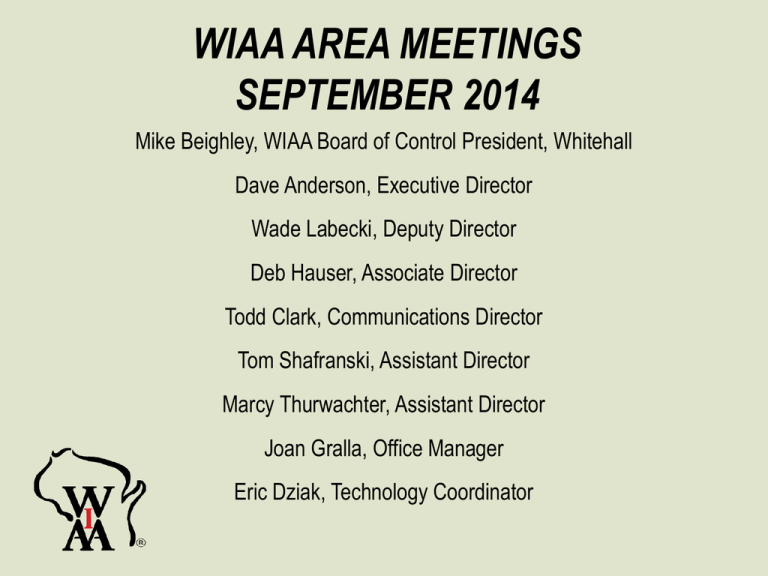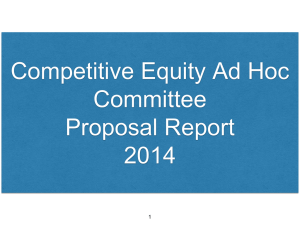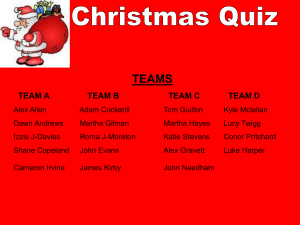Committee on Competitive Equity Update
advertisement

WIAA AREA MEETINGS SEPTEMBER 2014 Mike Beighley, WIAA Board of Control President, Whitehall Dave Anderson, Executive Director Wade Labecki, Deputy Director Deb Hauser, Associate Director Todd Clark, Communications Director Tom Shafranski, Assistant Director Marcy Thurwachter, Assistant Director Joan Gralla, Office Manager Eric Dziak, Technology Coordinator Welcome! Open Forum Your Questions/Concerns Committee on Competitive Equity Update September 8-Mount Horeb-Kyle Luedtke & Chris Zwettler September 9-Oconomowoc-Janet Bahr, David Bartelt & Gus Knitt September 10-Antigo-Dawn Urban September 15-Greenfield-Sandy Freres & Ryan Mangan September 16-Mauston-Ken Clinton, Archie Sherbinow & Ron Walsh September 23-Rice Lake-Steve Salisbury & Archie Sherbinow September 24-Fox Valley Lutheran, Appleton-Patrick Mans, Mark McQuade & Robert Pauly Competitive Equity Ad Hoc Committee Summer Work Report 2014 C/C Mission The committee formation was voted on by the membership at the Annual Meeting on April 16, 2014. The WIAA Board of Control appointed a 21-member team with representation from the seven districts. Representation included 12 from the public schools and nine from private schools: large and small schools; includes superintendents, principals, and athletic directors. There are no members from the Sports Advisory Committee, WIAA Executive Staff or Board of Control. The Mission of the Committee is to… study competitive balance/equity! evaluate the current procedure of using enrollment for division placement in post-season tournament plus offer a solution. Timeline The Committee would meet over the summer and present their findings at the September Area Meetings. The Committee would make their final recommendation to the Board of Control in December of 2014 for the 2015-2016 school year. The Committee may ask for more time if required. Competitive Equity was defined as “more schools have an opportunity to compete on a more level playing field in post-season play.” The Committee met twice: July 7-8 and Aug. 3-4 The following viable solutions were developed and investigated by the Committee: 1.65 multiplier Status quo Add a division in sports that would contain no private schools. (Exception: not in football) Long Term Success Factors: point system for regional,sectionals,and state that would accumulate and move a team up a division over an established period of time. Reducer: Subtract students on free and reduced lunch, or a percentage of those students from total enrollment. Solutions continued Equal distribution of private schools throughout division. Sport specific private/public separate state tournaments or path to the state tournament in tennis, golf, volleyball, and soccer. Geographical population multiplier (public and private) Out of feeder school/open enrolled student multiplier. Criteria Used for Assessing Potential Solutions Sport Specific Addresses schools in rural/urban areas. Universal application to all WIAA member schools. Clear, concise and supported by data. Can be reviewed and will be evaluated. Wisconsin has its own unique circumstances. The Committee reviewed what other states have done and then applied the criteria to meet the needs of the WIAA member schools. "I think each state association really has to do some soulsearching," says B. Elliot Hopkins, director of sports and educational services for the Indianapolis-based National Federation of State High School Associations, who also sits on the organization's Citizenship/Equity Committee. "What administrators do in one state may have no place in another state. There's no right or wrong; it's just what works best in that state at a particular time. You have to add that clarifier: 'at a particular time.'" Athletic Business “Criteria” applied to nine proposals! This resulted in three proposals that met the “Criteria” for further study. Reducer Success Factor Geographical, Boundary-Specific Multiplier Reducer Follows the Minnesota plan using free and reduced lunch numbers where 40% of the current free and reduced count. After 7 years, Minnesota continues to apply reducer to their schools. Can be applied to both private and public, rural and urban, and all sports. Data exists and can be audited. Research what % of students on free and reduced lunch actually participate in athletics for their schools. Options that need to be explored include: How do you count students? Do schools get bumped up? Do “large urban school”move down? Does it address the concerns of “rural schools”? Success Factor Measurable and easy to track Evaluates and impacts the least number of schools. Can be applied to all sports and public/private schools. Review 3 or 5 year records to improve speed of resolution. Establish a level point system for state tournament movement: regional, sectional and state championships. Can this process be combined with other options? Should the WIAA punish schools, public/private, for success? Will this provide a road for more rural schools to make a state appearance? Geographical, Boundary-Specific Multiplier Establish a radius for attendance regardless of open enrollment. Take all schools in Wisconsin and assign them a home attendance boundary. Add a multiplier to each student beyond boundary. Need to review how many students actually participate in athletics. Need to review feeder schools for private schools. Set up a model to see how this affects all schools and will this address rural/urban issues. Why not the Multiplier? The multiplier is not universally applied to all members. The multiplier does not take into account open enrollment/non-boundary schools in Wisconsin. While it might move some private schools, it does not solve the problem. Over time other schools would emerge. Empirical evidence from Missouri has indicated that the multiplier formula did not decrease the amount of state championships won by private schools. Two states (Georgia and Arkansas) have abandoned the multiplier format. Multiplier continued Not all private schools are the same and yet, the multiplier treats them the same. The goal of the committee is not to target just private schools, but to analyze all schools success factors. The committee did not believe the multiplier would address the concerns of the rural schools. The Committee will reconvene on Oct. 1, 2014. Each option is being studied in-depth and for evaluation on Oct. 1. The Committee will review modeled examples to see if the 3 options resolve issues to improve competitive balance/equity. The Competitive Equity Ad Hoc Committee will seek to recommend to the Board of Control their findings for the December Board meeting. The Committee acknowledges that their findings may be a combinations of options to best address Wisconsin’s uniqueness. Seeding State Tournaments Geography vs. Best Teams • Geographic Representation • Travel • School Time • Substitutes • Luck of the Draw • Boys Volleyball • Wrestling • Hockey • Softball • Girls Volleyball • Baseball • Tennis • Soccer • Basketball Seeding State Tournaments Geography vs. Best Teams • Coaches, Media and Public Sentiment • Extra Qualifiers • Sectional Assignments • Expectations • Your Thoughts Conference Realignment The Board of Control’s authority in conference alignment is outlined in the Constitution of the WIAA under Article VI-Powers and Duties of the Board of Control, Section 10, as follows: The Board of Control has the authority to take action to bring about a reasonable conference affiliation and relationship for member high schools. Reasonable conference affiliation and relationship with member high schools may include total movement of member schools, sport specific relief, and/or scheduling assistance. Note: It is not the intent to make wholesale changes in existing conference lines. It should be understood, however, that there could be shake-ups in areas where conference affiliation problems are particularly acute, and it may not be realistic to find a solution for every member school. For inclusion in a conference, any member high school, either through co-op application or by singular sponsorship, must offer one sport for boys and one sport for girls in the fall, winter, and spring. Schools that are not coeducational must adhere to a similar single-gender requirement. POSITION ON ALIGNMENT The Board of Control at its February, 1978, meeting adopted the following statement (editorially updated since that time) as its position on conference alignment: WHEREAS, the WIAA has been delegated the authority to establish conference alignment within its member schools, and WHEREAS, conference alignment creates an emotional issue with citizens, school boards and school personnel, and total agreement of those schools involved seems largely unattainable, and WHEREAS, the Board of Control desires to establish a procedure to accomplish realignment where necessary and yet provide for input from those directly involved, afford due process to the affected school and provide for final determination of issues. NOW, THEREFORE, the Board of Control establishes this procedure to be followed in realignment matters: 1. The Executive Director, or a delegate, is responsible for identifying conference alignments that merit consideration for adjustment. This identification will be determined following a petition from a conference or conferences, a request by a Board of Education or Governing Body of member school, or by declaration of the WIAA staff annually at the Area Meetings. 2. Working meeting(s) with administrators and/or Board of Education/Governing Body members of any of the schools potentially affected by changes in conference affiliation. Member schools are expected to send representatives with full knowledge of the impact of conference realignment and with the full authority to respond on the school’s behalf. Discussions will include, but not be limited to enrollments, travel and programs. After completing the working meetings, a preliminary recommendation will be formulated. 3. The preliminary recommendation(s) shall be made known to the affected schools and conferences before the Board of Control’s first consideration. The Board retains the right to alter the preliminary recommendation after first consideration. If the preliminary recommendation is altered, first consideration action will be delayed until the next scheduled Board of Control meeting. 4. Following Board of Control first consideration and resultant action on the preliminary recommendation, all affected schools and conferences shall be notified of the action. Any affected school or conference may petition for a hearing. The petition must be made within 40-days of the Board of Control action following first consideration. The hearing shall be held no later than the first regular Board of Control meeting after the 40-day petition deadline has expired. 5. All affected schools and conferences will be notified of the hearing date, time and location. The Board shall reserve the right to establish time limits on appearances by each school or conference. Testimony may be in written or verbal form. The Board of Control can accept or reject the initial action. Final Board of Control action will be taken no later than the regular meeting in the month following the hearing. BE IT RESOLVED, that the Board of Control of the WIAA adopts the following criteria to be applied in considering realignment proposals, listed in descending order of importance with the recognition that they are guidelines only, not each will be followed in every case: 1. There is no fixed number of schools required in a conference; the number may vary depending on many factors relating to others of these guidelines and availability of schools. 2. Distances to be traveled by competing schools shall be kept reasonable, and it is recognized greater distances may be required. 3. Size of enrollment of schools shall be considered and guidelines previously established by the Board of Control shall be used but shall not be absolute in any situations. 4. Comparability of athletic participation first, then comparability of other school sponsored activities shall be considered. 5. Traditional rivalries shall be considered. – – – – – – – – – – The Board of Control at its February, 1988, meeting made these provisions (editorially updated since that time) part of the official position on conference alignment: 1. WIAA schools must assume an “ownership” of conference alignment problems if solutions are to be found. 2. The Board of Control will play the role of an appeals body in all future alignment transactions. 3. Alignment changes will be reviewed as necessary at the request of member schools. The annual area meetings will serve as a way for schools to voice their concerns. 4. Inasmuch as schools desire tournament competition on a divisional basis, membership in a conference will attempt to follow the same idea. Efforts will be made to eliminate situations in which a conference contains schools from more than two divisions. 5. Odd-numbered conferences are workable as long as there are other odd-numbered conferences in the immediate area to take care of bye dates, particularly in football. Conference Realignment • Area Meetings • Formal Request to be made at Annual Meeting • Statewide Realignment—Every 8 years? • Single School Requests—When/How to Say “No” • Other Suggestions 2014 Constitutional Changes • Football coaches to follow the fall acclimatization policy during their summertime unrestricted school coaching contact days. • All sports with unlimited non-school coaching contact will be the same. • All coaches, including assistant coaches, to fulfill rules meeting requirements. 2015 Proposed Constitutional Amendments • Require a member school to maintain one sport. • Remove restitution penalty provided to Board of Control in Constitution. • Designate a date in which amendments may be brought to the membership via petition to allow discussion and committee review prior to the Annual Meeting. • Allow students to participate in skills contests during the season. • Allow from June 15-July 15 unrestricted school sponsored contact in basketball for individual instruction use only. 2015 Proposed Constitutional Amendments • Open unrestricted school coaching contact to all sports except football to the entire period between the last day of school to July 31. • Open unlimited non-school coaching contact to all sports except football for the period between the last day of school to the first day of school. • Allow underclassmen to participate in all-star competitions during the summer. • Editorial—Clarify conference realignment procedures 2014 Sportsmanship Summit Wednesday, December 3 Holiday Inn Convention Center, Stevens Point, WI Introduction—All Members Welcome Schedule Topics and Presenters Registration 8 Player Football Championship At its January 29, 2014 meeting, the Board of Control approved the implementation of a 16-team tournament one year following the season in which 30 or more schools are sponsoring 8-player football. In line with 11 player qualifying. Boys Basketball 100th Anniversary • Celebrating the Game – Local Celebrations During Season • Memorabilia—Have Any? • Pack the Kohl • 3-Point Challenge • Watch for More Info Officials Licensing and Ranking New for 2014-15: • Officials can access all information on the WIAA website with a single login. • Officials online Directory is updated daily. • RefRanking is no longer the platform used for coaches to rank officials. • Rankings will be submitted through Athletix.us. Instruction guides are on the Athletix website and information has been provided to athletic directors. Political and Legal Landscapes • Non-school competition in other states • Illinois and its legislature • California and transfer rule • Legal implications and realignment • First Aid, CPR and AED Training • LRB 2032 and AB 520 Participation Inclusive, not exclusive It’s About More Than Winning Timely Reminders—Updates—Announcements Conference Realignment Thank You! Have a Great Year!







